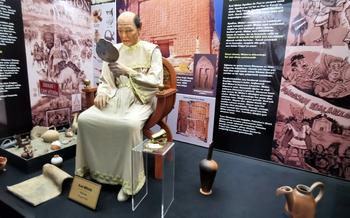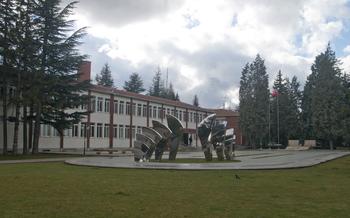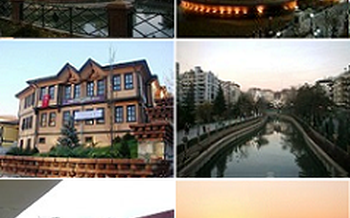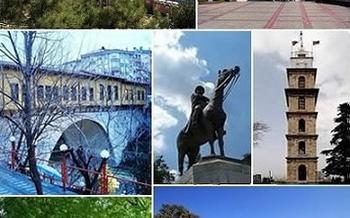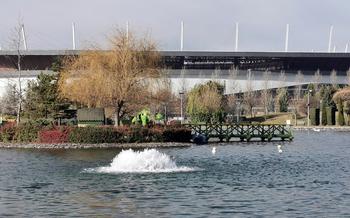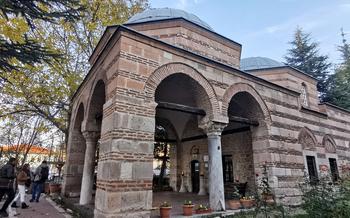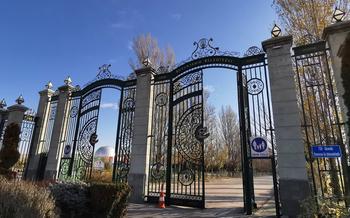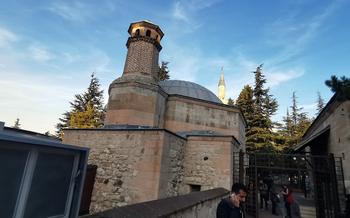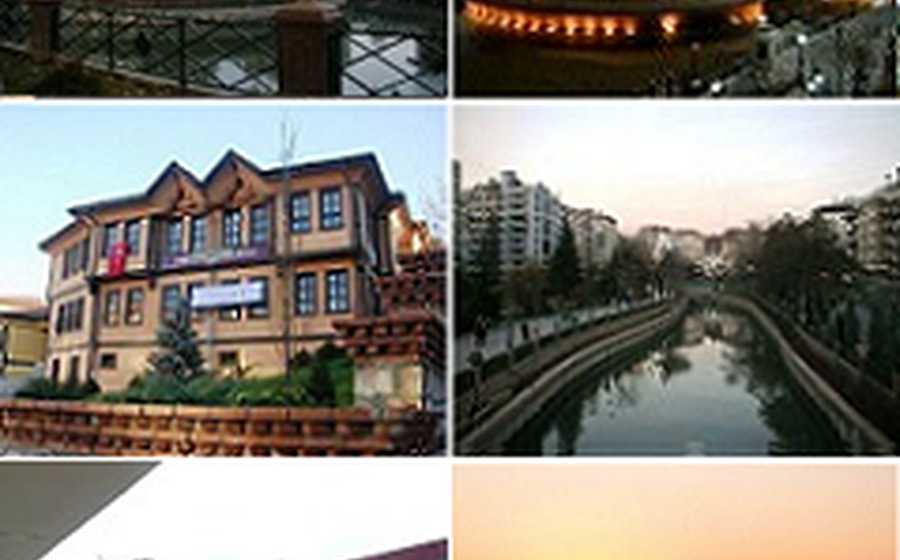
Vilayet Square
- Vilayet Square: A Symbol of Modernity
- The Grand Post Office Building: A Masterpiece of Neoclassical Architecture
- The Government Building: A Majestic Symbol of Authority
- The City Hall: A Center of Civic Administration
- The Ataturk Statue: A Tribute to the Father of Modern Turkey
- The Independence Monument: A Reminder of Turkey's Struggle for Freedom
- The Republic Monument: A Celebration of Turkey's Democratic Achievements
- The Eskişehir Archaeology and Ethnography Museum: A Window into the Region's Past
- The Porsuk River: A Picturesque Waterway in the Heart of the City
- The Kentpark: A Tranquil Oasis in the City Center
- Sazova Park: A Natural Retreat on the City's Outskirts
- The Odunpazarı District: A Historical Gem with Traditional Ottoman Architecture
- The Kurşunlu Mosque: A Beautiful Example of Seljuk Architecture
- Insider Tip: Experience the Local Cuisine
Vilayet Square: A Symbol of Modernity
Vilayet Square stands as a testament to Eskişehir's transformation from a sleepy Ottoman town to a vibrant and modern city. Laid out in the late 19th century, the square represents a bold departure from traditional urban planning, showcasing a harmonious blend of architectural styles that reflect Turkey's transition into the modern era. The square serves as the heart of the city, a bustling hub where locals and visitors alike gather to socialize, celebrate, and embrace the city's energetic spirit.
Historical Background:
Vilayet Square's origins can be traced back to the late 1800s when Eskişehir was designated as the capital of the newly formed Vilayet of Hüdavendigar. To mark this significant milestone, the Ottoman authorities commissioned a grand urban renewal project that would transform the city into a modern administrative center. The square was conceived as the centerpiece of this ambitious plan, symbolizing the city's newfound status and progressive outlook.
Architectural Significance:
The buildings surrounding Vilayet Square are a testament to the architectural diversity that characterized the late Ottoman period. The square features a captivating blend of neoclassical, art nouveau, and traditional Ottoman styles, reflecting the eclectic influences that shaped Turkey's architectural landscape at the turn of the 20th century. The harmonious coexistence of these architectural styles creates a visually striking and cohesive ensemble that is unique to Eskişehir.
Importance as a Gathering Place:
Vilayet Square has always been more than just a physical space. It has served as a vibrant gathering place for the people of Eskişehir, hosting countless events, celebrations, and protests throughout its history. Whether it's the weekly farmers' market, national holidays, or political rallies, the square provides a platform for the community to come together, share ideas, and forge connections.
Personal Anecdote:
I vividly remember my first visit to Vilayet Square during a bustling summer evening. The square was teeming with life, as families strolled along the cobblestone paths, children played in the fountains, and vendors sold traditional Turkish delights from their colorful stalls. The air was filled with laughter, music, and the sweet aroma of freshly baked pastries, creating an unforgettable atmosphere that left me captivated by the city's energy and charm.
The Grand Post Office Building: A Masterpiece of Neoclassical Architecture
The Grand Post Office Building in Eskişehir stands as a testament to the city's rich architectural heritage and its role as a center of communication. Constructed in 1892, the building boasts an impressive neoclassical design, featuring symmetrical facades, intricate carvings, and a grand entrance portico. Its construction marked a significant milestone in Eskişehir's modernization, providing a vital link to the outside world through postal services.
The building's architectural style, characterized by its classical proportions and elegant ornamentation, reflects the influence of European architectural trends of the time. Its imposing presence on Vilayet Square is a reminder of the important role played by communication in the development of modern Turkey.
Today, the Grand Post Office Building continues to serve as a functioning post office, offering a range of postal and telecommunication services to the local community. Visitors to the building can admire its architectural grandeur and step back in time to experience the ambiance of a bygone era. The building's accessibility, located in the heart of the city, makes it a popular destination for both locals and tourists alike.
An interesting fact about the building's construction is that it was built using locally sourced materials, including a type of volcanic rock known as 'tüf'. This durable and lightweight material contributed to the building's resilience and longevity, allowing it to withstand the test of time and remain a prominent landmark in Eskişehir's urban landscape.
The Government Building: A Majestic Symbol of Authority
The Government Building, an imposing structure located in the heart of Vilayet Square, stands as a testament to the authority and presence of the local government in Eskişehir. Erected during the late 19th century, this architectural masterpiece showcases a blend of Neoclassical and Ottoman influences, reflecting the city's rich cultural heritage. Its grand facade, adorned with intricate carvings and decorative elements, speaks to the importance and grandeur of the institution it houses.
Inside, the building boasts spacious halls, elegant staircases, and ornate chandeliers, creating an atmosphere of sophistication and power. The main hall, where official meetings and events take place, features a high ceiling, polished marble floors, and rows of plush seating, emphasizing the solemnity and significance of the proceedings held within. The various offices and departments housed within the building cater to the administrative needs of the city, ensuring the smooth functioning of local governance.
Currently, the Government Building remains in active use, serving as the seat of the provincial governor and hosting various government departments. Visitors are welcome to explore the building's exterior and admire its architectural features, but access to the interior is generally restricted to authorized personnel. Nonetheless, the mere presence of this majestic structure serves as a reminder of the important role that local government plays in shaping the city's development and progress.
In my own experience, I had the privilege of attending an official event at the Government Building during my visit to Eskişehir. The grandeur of the setting, combined with the solemnity of the occasion, left a lasting impression on me. The meticulously maintained interiors, the respectful demeanor of the staff, and the sense of purpose that permeated the atmosphere all contributed to a truly memorable experience.
The City Hall: A Center of Civic Administration
The City Hall is an imposing structure located in the heart of Vilayet Square. Built in the early 20th century, the building is a testament to the city's rapid growth and modernization during that era. Its grand facade, adorned with intricate carvings and sculptures, reflects the architectural style prevalent in Turkey at the time.
As the seat of local government, the City Hall plays a crucial role in the administration of Eskişehir. It houses the offices of the mayor, city council, and various municipal departments. The building is also a venue for important civic events, such as council meetings, public hearings, and cultural programs.
The City Hall is open to the public during business hours. Visitors can admire its impressive architecture, learn about the city's history and governance, and observe local government in action. Guided tours are also available upon request.
Interesting Fact: The City Hall underwent a major renovation in the 1980s to restore its original grandeur. During the renovation, workers discovered a hidden time capsule containing documents and artifacts from the building's construction. These items now form part of the City Hall's historical collection.
The Ataturk Statue: A Tribute to the Father of Modern Turkey
The Ataturk Statue, standing tall and proud in Vilayet Square, is a poignant tribute to Mustafa Kemal Ataturk, the revered founder of modern Turkey. Unveiled in 1927, this majestic bronze sculpture captures the essence of Ataturk's indomitable spirit and his visionary leadership. The statue depicts Ataturk in his military uniform, his piercing gaze fixed upon the future, symbolizing his unwavering determination to lead Turkey towards progress and modernization.
The artistic style of the statue reflects the prevailing aesthetics of the early 20th century, characterized by its realistic portrayal and attention to detail. The sculptor, Heinrich Krippel, masterfully rendered Ataturk's likeness, capturing the strength and resolve that defined his character. The statue stands atop a granite pedestal, adorned with intricate carvings that pay homage to Ataturk's military achievements and his role in shaping Turkey's destiny.
The Ataturk Statue holds immense significance as a symbol of national pride and a reminder of Ataturk's enduring legacy. It serves as a focal point for national celebrations and commemorations, where citizens gather to honor the memory of the man who transformed Turkey into a modern, secular republic. During national holidays, the statue is draped in the Turkish flag, and wreaths of flowers are laid at its base, paying tribute to Ataturk's unwavering dedication to his country.
In my personal experience, visiting the Ataturk Statue during a national holiday was a deeply moving experience. The square was abuzz with patriotic fervor as people from all walks of life came together to celebrate Ataturk's vision and accomplishments. The sight of the statue, bathed in the warm glow of the setting sun, against the backdrop of the Turkish flag fluttering in the breeze, was truly awe-inspiring. It was a moment that left an indelible mark on my memory, reminding me of the profound impact Ataturk had on shaping the nation of Turkey.
The Independence Monument: A Reminder of Turkey's Struggle for Freedom
Erected in the heart of Vilayet Square, the Independence Monument stands as a powerful reminder of Turkey's valiant struggle for freedom and independence. Unveiled in 1923, the year the Republic of Turkey was proclaimed, this symbolic monument pays homage to the countless Turkish soldiers and civilians who sacrificed their lives in the Turkish War of Independence.
The monument's design is a poignant representation of Turkey's unwavering determination to break free from the shackles of foreign rule. At its center, a towering obelisk symbolizes the nation's resilience and indomitable spirit. Surrounding the obelisk are four bronze figures, each representing a different aspect of the Turkish nation: a soldier, a woman, a farmer, and a worker. These figures embody the unity and strength of the Turkish people, who stood united against all odds to achieve their independence.
The Independence Monument is not merely a historical landmark but also a symbol of national pride and unity. Every year, on the anniversary of the Turkish Republic's foundation, thousands of people gather around the monument to commemorate the sacrifices made by their ancestors and to celebrate the freedom they now cherish. It is a place where the spirit of patriotism and love for the motherland burns brightly, reminding every Turkish citizen of the hard-won independence that they must protect and preserve.
The Republic Monument: A Celebration of Turkey's Democratic Achievements
The Republic Monument stands as a proud symbol of Turkey's journey towards progress and modernity. Unveiled in 1933, the monument marks the 10th anniversary of the foundation of the Turkish Republic by Mustafa Kemal Atatürk. Its striking design features a towering obelisk flanked by bronze figures representing the Turkish nation, symbolizing their unity and determination.
The monument's artistic style is a blend of classical and modern elements, reflecting Turkey's transition from its Ottoman past to a forward-looking republic. The obelisk, reminiscent of ancient Egyptian monuments, represents the country's historical roots, while the bronze figures embody the dynamism and progressiveness of the new era.
The Republic Monument holds immense significance as a symbol of national pride and unity. It serves as a reminder of the sacrifices made by the Turkish people during the Turkish War of Independence and their unwavering commitment to building a democratic and prosperous nation.
Personal Anecdote:
I vividly recall attending a ceremony at the Republic Monument during Turkey's Republic Day celebrations. The atmosphere was electric, with citizens from all walks of life gathered to commemorate this momentous occasion. As the Turkish national anthem played, I felt a surge of patriotism and pride, witnessing the deep respect and admiration the Turkish people have for their republic. The monument stood as a testament to the nation's resilience and its unwavering commitment to democratic ideals.
The Eskişehir Archaeology and Ethnography Museum: A Window into the Region's Past
The Eskişehir Archaeology and Ethnography Museum stands as a testament to the rich cultural heritage of Eskişehir and the surrounding region. Founded in 1963, the museum houses a diverse collection of artifacts and exhibits that provide a glimpse into the area's fascinating history and traditions.
The museum's archaeological section showcases a range of impressive finds from prehistoric times to the Ottoman period. Visitors can marvel at ancient pottery, tools, weapons, and jewelry, all of which offer insights into the lives and cultures of the region's earliest inhabitants. The ethnography section, on the other hand, focuses on the traditional customs, lifestyles, and crafts of the region's diverse ethnic groups. Visitors can explore displays of traditional costumes, household items, and agricultural tools, gaining a deeper understanding of the region's cultural diversity.
Among the museum's highlights is a unique collection of Phrygian artifacts, including intricately carved stone reliefs, pottery, and jewelry. These artifacts provide a glimpse into the vibrant culture of the Phrygians, an ancient civilization that flourished in the region during the 1st millennium BC. Another highlight is the museum's collection of Ottoman-era artifacts, including ornate calligraphy, decorative tiles, and intricate metalwork. These artifacts showcase the rich artistic traditions of the Ottoman Empire, which ruled over the region for centuries.
The Eskişehir Archaeology and Ethnography Museum is not just a repository of cultural heritage; it also serves as an active center for research and education. The museum regularly hosts temporary exhibitions, lectures, and workshops that explore various aspects of the region's history and culture. Visitors can also take guided tours of the museum, led by knowledgeable docents who provide insights into the significance of the exhibits and the stories they tell.
In conclusion, the Eskişehir Archaeology and Ethnography Museum is a must-visit destination for anyone interested in exploring the rich cultural heritage of Eskişehir and the surrounding region. Its diverse collection of artifacts, interactive exhibits, and educational programs offer visitors a unique opportunity to delve into the past and gain a deeper understanding of the region's cultural tapestry.
The Porsuk River: A Picturesque Waterway in the Heart of the City
The Porsuk River, a serene waterway that meanders through the heart of Eskişehir, adds a touch of natural beauty and tranquility to the urban landscape. Originating from the highlands of Kütahya, the river flows through the city center before merging with the Sakarya River.
Historically, the Porsuk River played a pivotal role in the development of Eskişehir. It served as a vital transportation route, facilitating trade and commerce between the city and the surrounding regions. The river's fertile banks also attracted farmers and settlers, contributing to the growth and prosperity of the city.
Today, the Porsuk River is a popular destination for locals and tourists alike. Its picturesque setting, lined with lush greenery and adorned with charming bridges, offers a welcome respite from the hustle and bustle of city life. Visitors can enjoy leisurely walks or bike rides along the riverbank, taking in the scenic views and the tranquil atmosphere.
For a unique perspective of the city, one can embark on a boat ride along the Porsuk River. These boat tours offer a delightful way to explore the city's landmarks and attractions from a different vantage point. As the boat glides along the river, passengers can admire the architectural wonders that grace the riverbanks, including the historic bridges, mosques, and government buildings.
One of the most popular attractions along the Porsuk River is the Porsuk River Park. This beautifully landscaped park, located on the banks of the river, offers a variety of recreational opportunities for visitors. With its lush gardens, walking paths, and playgrounds, the park is a perfect place to relax, unwind, and enjoy the outdoors.
Personal Anecdote:
During my visit to Eskişehir, I had the opportunity to experience the charm of the Porsuk River firsthand. One evening, I took a leisurely stroll along the riverbank, marveling at the stunning views of the illuminated city skyline. The gentle breeze carried the sound of birdsong and the laughter of children playing in the nearby park. It was a truly magical moment, and I couldn't help but feel a sense of peace and tranquility as I watched the river flow gently by.
The Kentpark: A Tranquil Oasis in the City Center
In the heart of Eskişehir, nestled amidst the bustling streets, lies the Kentpark, an urban oasis that offers respite from the city's vibrant energy. This sprawling green space, designed by renowned landscape architect Mimar Vedat Dalokay, is a testament to the city's commitment to sustainable urban planning.
Established in 1971, the Kentpark was conceived as a sanctuary for both locals and tourists alike, providing a much-needed escape from the concrete jungle. With its lush gardens, tranquil ponds, and towering trees, the park is a haven of tranquility, inviting visitors to reconnect with nature and find solace amidst the urban hum.
Beyond its aesthetic appeal, the Kentpark also serves as an important recreational hub. Families flock to the park's playgrounds, where children can frolic and burn off energy. Jogging paths and cycling trails weave through the park's verdant expanse, providing ample opportunities for fitness enthusiasts to stay active.
One of the highlights of the Kentpark is its unique landscaping. Dalokay ingeniously incorporated the park's natural features, such as the existing topography and water bodies, into his design. The result is a harmonious blend of natural and man-made elements that creates a truly immersive experience for visitors.
The park is also home to several cultural attractions, including an amphitheater, an art gallery, and a library. These venues host a variety of events throughout the year, ranging from concerts and plays to art exhibitions and book readings.
Whether you seek solitude, recreation, or cultural enrichment, the Kentpark has something to offer everyone. It is a place where the city's residents and visitors can come together to relax, recharge, and celebrate the beauty of nature.
Sazova Park: A Natural Retreat on the City's Outskirts
Nestled on the outskirts of Eskişehir, Sazova Park beckons nature enthusiasts with its tranquil ambiance and diverse attractions. Steeped in history, the park was once a hunting ground for Ottoman sultans, who sought solace and recreation amidst its serene landscapes. Today, it has transformed into a beloved recreational haven for locals and tourists alike.
Visitors to Sazova Park are greeted by a breathtaking panorama of rolling hills, lush greenery, and shimmering waters. The park's centerpiece is the Sazova Lake, a tranquil oasis that invites visitors to embark on leisurely boat rides or fishing expeditions. Along the lake's serene shores, visitors can unwind in cozy cafes or savor delicious meals at lakeside restaurants, immersing themselves in the park's tranquil atmosphere.
Beyond the lake, Sazova Park offers a plethora of outdoor activities for adventure seekers. Hiking trails meander through dense forests, leading to hidden waterfalls and panoramic viewpoints. Mountain biking enthusiasts can traverse challenging trails, while horseback riding excursions provide a unique perspective of the park's natural beauty. For those seeking a more relaxed experience, picnic areas nestled amidst fragrant pine trees offer the perfect setting for a leisurely lunch break.
In addition to its natural attractions, Sazova Park is home to several historical landmarks that provide a glimpse into the region's rich past. The park's most prominent historical site is the Sazova Mansion, a grand structure that once served as a hunting lodge for Ottoman sultans. Today, the mansion has been meticulously restored and transformed into a museum, showcasing artifacts and exhibits that narrate the fascinating history of Sazova Park and its royal connections.
Sazova Park stands as a testament to Eskişehir's commitment to preserving its natural and cultural heritage. Whether you seek adventure, relaxation, or a journey through history, this enchanting park offers a sanctuary for all to enjoy.
The Odunpazarı District: A Historical Gem with Traditional Ottoman Architecture
The Odunpazarı district is a captivating neighborhood in Eskişehir, renowned for its well-preserved Ottoman-era architecture. Step into this historical gem and be transported back in time as you wander along its cobblestone streets, lined with charming wooden houses and historic landmarks.
The district's rich history dates back to the 15th century, when it served as a bustling trading center. Its name, Odunpazarı, translates to "wood market," a testament to its past as a hub for timber trade. Over the centuries, Odunpazarı has undergone meticulous restoration efforts, transforming it into a vibrant cultural and tourist destination.
Today, the district exudes an enchanting atmosphere, with its traditional Ottoman houses adorned with intricate carvings and colorful facades. These historic buildings have been carefully restored and repurposed, housing boutique hotels, art galleries, souvenir shops, and cozy cafes.
As you explore Odunpazarı, don't miss the opportunity to visit the historic Odunpazarı Mosque, a beautiful example of Ottoman architecture. Built in the 18th century, the mosque features a graceful minaret and a serene courtyard, inviting visitors to pause and reflect.
Another must-see attraction is the Kurşunlu Mosque, renowned for its unique lead-covered dome. This 16th-century mosque is a testament to the architectural prowess of the Ottoman era and offers a glimpse into the city's rich Islamic heritage.
Strolling through the narrow streets of Odunpazarı, you'll discover hidden courtyards, artisan workshops, and traditional Turkish handicrafts. Take your time to browse the local shops, where you can find handmade souvenirs, jewelry, and textiles, perfect for taking home a piece of Eskişehir's charm.
As the sun begins to set, the district transforms into a magical wonderland, with the warm glow of lanterns illuminating the cobblestone streets. Enjoy a leisurely dinner at one of the many traditional restaurants, savoring the flavors of Turkish cuisine amidst the historical ambiance.
Whether you're a history buff, an architecture enthusiast, or simply someone who appreciates the beauty of well-preserved heritage, Odunpazarı is a must-visit destination in Eskişehir. Immerse yourself in the charm of this historical district and discover the rich cultural tapestry that makes Eskişehir a truly special city.
The Kurşunlu Mosque: A Beautiful Example of Seljuk Architecture
Located in the heart of the historic Odunpazarı district, the Kurşunlu Mosque stands as a testament to the architectural prowess of the Seljuk dynasty. Built in the 14th century, the mosque's striking features include its intricately carved stonework, elegant calligraphy adorning its walls, and a stunning turquoise-tiled dome that dominates the skyline. The mosque's name, "Kurşunlu," translates to "leaded," a reference to the lead sheets that once covered its roof. Inside, visitors are greeted by a serene atmosphere, with a spacious prayer hall and a beautifully decorated mihrab, indicating the direction of Mecca. The mosque's historic significance and architectural beauty make it a must-visit for anyone interested in Turkish history and Islamic architecture.
In my personal experience, visiting the Kurşunlu Mosque during prayer time was a truly moving experience. The melodious call to prayer reverberated through the air, and the mosque's interior was filled with a sense of devotion and tranquility. As I observed the worshippers engaged in their prayers, I couldn't help but feel a profound connection to the history and culture of this ancient city.
Insider Tip: Experience the Local Cuisine
Eskişehir's culinary scene offers a delightful blend of traditional Turkish flavors and modern culinary innovations. Indulge in the tantalizing aroma of freshly baked simit, a sesame-encrusted bread, or savor the succulent flavors of mantı, delicate dumplings filled with minced meat and yogurt sauce. Don't miss the chance to try çiğ börek, crispy phyllo pastries stuffed with herbs and cheese, or gözleme, a savory flatbread filled with various fillings.
For a truly authentic experience, venture into the city's vibrant local markets, where you can browse colorful stalls laden with fresh produce, aromatic spices, and traditional sweets. Immerse yourself in the lively atmosphere of a food festival, where you can sample a diverse array of local delicacies and mingle with friendly locals.
One of my most memorable culinary experiences in Eskişehir was at a small, family-run restaurant tucked away in the charming Odunpazarı district. The aroma of grilled meats and freshly baked bread wafted through the air as I eagerly awaited my order of iskender kebab, a mouthwatering combination of thinly sliced döner meat, tangy tomato sauce, and creamy yogurt. The flavors were simply divine, and I couldn't resist savoring every bite.
Whether you're a food enthusiast or simply looking to experience the local culture, Eskişehir's culinary delights are sure to tantalize your taste buds and leave you with lasting memories.
